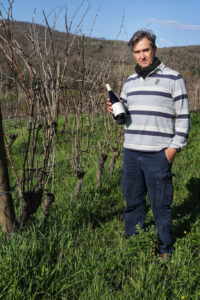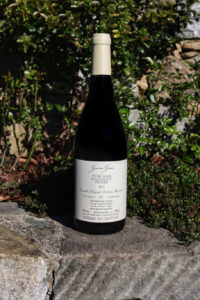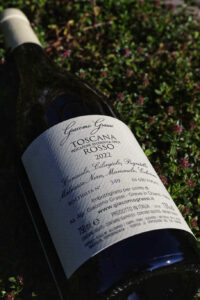By Rosina Fracassini
Amidst the centuries-old vineyards of the Chianti hills, a new wine is emerging—one that represents the result of years of research and dedication. Born from a project that evolved over time, focusing on constant growth and innovation, this wine is called Pigole di Dudda, the first label (vintage 2020 – bottled in 2022) from Azienda Agricola Giacomo Grassi. But it’s more than just the product of a harvest—it’s the outcome of years of study, experimentation, and above all, a deep passion and love for viticulture.

The story of Pigole di Dudda begins back in 2004, when Giacomo Grassi found himself with a hectare of Chianti Classico and IGT planting rights. From the very start, his approach to viticulture went beyond simply following tradition. He aimed for growth and research, seeking a rediscovery of the past that would respect the land and its roots.
At the time, the Italian wine market was caught up in a trend: French grape varieties were in high demand and seemed to represent the way forward. Giacomo—an agronomist who also works as a consultant for other farms—took the opportunity to pursue a Master’s in Viticulture in Bordeaux.
 After studying these grape varieties in depth, he realized that behind the trend was little authenticity or long-term potential: French wines had found success not because they matched the Tuscan soil, but due to clever marketing. What seemed like a passing fashion would soon make way for a renewed appreciation of native grape varieties—those that have defined the Tuscan landscape for centuries.
After studying these grape varieties in depth, he realized that behind the trend was little authenticity or long-term potential: French wines had found success not because they matched the Tuscan soil, but due to clever marketing. What seemed like a passing fashion would soon make way for a renewed appreciation of native grape varieties—those that have defined the Tuscan landscape for centuries.
Back in Italy, he continued his studies. At one point, while going through notes from a bygone era, Giacomo came across a 1922 pamphlet about forgotten grape varieties. Inside it, a painting by 17th-century artist Bartolomeo Bimbi (1648–1729) depicted about 30 types of grapes that had existed in Tuscany over 300 years ago.
That document made a deep impression, sparking a desire to rediscover those lesser-known grape varieties that had stood the test of time. What began as historical curiosity soon became a true mission.
Giacomo decided to plant eight of these minor varieties in eight small pigole—the Tuscan term for small, irregular plots of land. These ancient, lesser-known grape varieties, each with its own history and personality, included Canaiolo, Malvasia Nera, Colorino, Pugnitello, Mammolo, Ciliegiolo, Foglia Tonda, and Abrusco. These grapes tell the story of a land that continues to evolve while proudly preserving its heritage.
 In 2020, as the pandemic disrupted everything, Giacomo faced a new challenge: with all olive oil events canceled, he suddenly had more time to dedicate to his vineyards. One vineyard of Sangiovese—neither particularly young nor old—left him uncertain about its potential for long-aging wine. So, he decided to complement it with a pigola of Canaiolo and one of Colorino. When harvest came, however, he realized that the Sangiovese grapes were perfect on their own—no blending needed.
In 2020, as the pandemic disrupted everything, Giacomo faced a new challenge: with all olive oil events canceled, he suddenly had more time to dedicate to his vineyards. One vineyard of Sangiovese—neither particularly young nor old—left him uncertain about its potential for long-aging wine. So, he decided to complement it with a pigola of Canaiolo and one of Colorino. When harvest came, however, he realized that the Sangiovese grapes were perfect on their own—no blending needed.
But the Canaiolo and Colorino grapes were there, ready to be harvested.
What had begun as a fallback plan for a potentially underwhelming harvest turned into something extraordinary: a wine composed of 70% Canaiolo and 30% Colorino. Giacomo described it as an ode to simplicity and to the land. Over the following months, the wine revealed more and more depth.
The idea he had formed during his studies in France—visiting the Rhône Valley and discovering the famous Châteauneuf-du-Pape (a wine made from thirteen different grape varieties)—was taking shape. A vision of wine that develops over time, just like the great wines that need years to fully express their essence.
 In the 2021 vintage, Giacomo added Ciliegiolo and Mammolo to the blend, enriching it with new nuances and complexity. Then in 2022, when the dream began to take real shape, he decided to include Malvasia Nera and Pugnitello—a bold move that produced an even more fascinating and complex wine, with a bouquet that took those who tasted it on a unique sensory journey.
In the 2021 vintage, Giacomo added Ciliegiolo and Mammolo to the blend, enriching it with new nuances and complexity. Then in 2022, when the dream began to take real shape, he decided to include Malvasia Nera and Pugnitello—a bold move that produced an even more fascinating and complex wine, with a bouquet that took those who tasted it on a unique sensory journey.
Production remained small, just 600–700 bottles, but the little dream that was taking shape began to win the hearts of wine lovers.
The year 2023 proved challenging for grapes, with unfavorable weather leading to a poor harvest. Despite managing to save some of the grapes, Giacomo chose not to vinify them. The market had offered very high prices, but in a gesture of respect for the land and the integrity of his project, he decided to sell the grapes without turning them into wine.
And so we arrive at 2024—the year when Pigole di Dudda finally takes its definitive form. Giacomo added Foglia Tonda and Abrusco to his already rich blend, though in very small quantities. The result is a Pigole di Dudda that perfectly embodies the idea of complexity: a wine that reveals something new in every sip, with notes of red fruits, spices, and a depth that evolves with each taste.
In 2024, Pigole di Dudda is ready to share its story with the world: a wine born from years of research, passion, and bold decisions. It is not just a “product” but the fulfillment of a dream—one that promises to grow and evolve with time. A tribute to the land, to historical memory, and to a future that becomes more real with every bottle.
DID YOU KNOW?
Pigola: In agricultural terms, a field with an irregular shape, usually a leftover plot after a larger property is divided into regular (mostly rectangular) parcels. (source: www.Treccani.it)
Info: Azienda Agricola Giacomo Grassi, Case di Dudda, Greve in Chianti (Fi) / Tel. 335 5391535 / www.giacomograssi.it / info@giacomograssi.com
